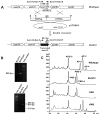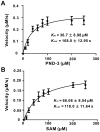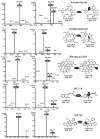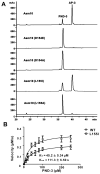N-methylation of the amide bond by methyltransferase asm10 in ansamitocin biosynthesis
- PMID: 21681880
- PMCID: PMC3391011
- DOI: 10.1002/cbic.201100062
N-methylation of the amide bond by methyltransferase asm10 in ansamitocin biosynthesis
Abstract
Ansamitocins are potent antitumor agents produced by Actinosynnema pretiosum. As deduced from their structures, an N-methylation on the amide bond is required among the various modifications. The protein encoded by asm10 belongs to the SAM-dependent methyltransferase family. Through gene inactivation and complementation, asm10 was proved to be responsible for the N-methylation of ansamitocins. Asm10 is a 33.0 kDa monomer, as determined by gel filtration. By using N-desmethyl-ansamitocin P-3 as substrate, the optimal temperature and pH for Asm10 catalysis were determined to be 32 °C and 10.0, respectively. Asm10 also showed broad substrate flexibility toward other N-desmethyl-ansamycins and synthetic indolin-2-ones. Through site-directed mutagenesis, Asp154 and Leu155 of Asm10 were confirmed to be essential for its catalysis, possibly through the binding of SAM. The characterization of this unique N-methyltransferase has enriched the toolbox for engineering N-methylated derivatives from both natural and synthetic compounds; this will allow known potential drugs to be modified.
Copyright © 2011 WILEY-VCH Verlag GmbH & Co. KGaA, Weinheim.
Figures






Similar articles
-
Amide N-glycosylation by Asm25, an N-glycosyltransferase of ansamitocins.Chem Biol. 2008 Aug 25;15(8):863-74. doi: 10.1016/j.chembiol.2008.06.007. Chem Biol. 2008. PMID: 18721757
-
The post-polyketide synthase modification steps in the biosynthesis of the antitumor agent ansamitocin by Actinosynnema pretiosum.J Am Chem Soc. 2003 Nov 26;125(47):14236-7. doi: 10.1021/ja038166y. J Am Chem Soc. 2003. PMID: 14624546
-
Mutational biosynthesis of ansamitocin antibiotics: a diversity-oriented approach to exploit biosynthetic flexibility.Chembiochem. 2011 Mar 7;12(4):540-7. doi: 10.1002/cbic.201000608. Epub 2011 Jan 27. Chembiochem. 2011. PMID: 22238146
-
Enzymatic methylation of the amide bond.Curr Opin Struct Biol. 2020 Dec;65:79-88. doi: 10.1016/j.sbi.2020.06.004. Epub 2020 Jul 10. Curr Opin Struct Biol. 2020. PMID: 32653730 Review.
-
Recent developments in the maytansinoid antitumor agents.Chem Pharm Bull (Tokyo). 2004 Jan;52(1):1-26. doi: 10.1248/cpb.52.1. Chem Pharm Bull (Tokyo). 2004. PMID: 14709862 Review.
Cited by
-
A molecular mechanism for the enzymatic methylation of nitrogen atoms within peptide bonds.Sci Adv. 2018 Aug 24;4(8):eaat2720. doi: 10.1126/sciadv.aat2720. eCollection 2018 Aug. Sci Adv. 2018. PMID: 30151425 Free PMC article.
-
A Permissive Amide N-Methyltransferase for Dithiolopyrrolones.ACS Catal. 2023 Feb 3;13(3):1899-1905. doi: 10.1021/acscatal.2c05439. Epub 2023 Jan 18. ACS Catal. 2023. PMID: 38106463 Free PMC article.
-
Identification and characterization of a welwitindolinone alkaloid biosynthetic gene cluster in the stigonematalean Cyanobacterium Hapalosiphon welwitschii.Chembiochem. 2014 Mar 21;15(5):665-9. doi: 10.1002/cbic.201300794. Chembiochem. 2014. PMID: 24677572 Free PMC article.
-
Epipolythiodioxopiperazine-Based Natural Products: Building Blocks, Biosynthesis and Biological Activities.Chembiochem. 2022 Dec 5;23(23):e202200341. doi: 10.1002/cbic.202200341. Epub 2022 Sep 15. Chembiochem. 2022. PMID: 35997236 Free PMC article. Review.
References
-
- Higashide E, Asai M, Ootsu K, Tanida S, Kozai Y, Hasegawa T, Kishi T, Sugino Y, Yoneda M. Nature. 1977;270:721–722. - PubMed
-
- Tanida S, Hasegawa T, Hatano K, Higashide E, Yoneda M. J Antibiot (Tokyo) 1980;33:192–198. - PubMed
-
- Cassady JM, Chan KK, Floss HG, Leistner E. Chem Pharm Bull (Tokyo) 2004;52:1–26. - PubMed
-
- Spiteller P, Bai L, Shang G, Carroll BJ, Yu TW, Floss HG. J Am Chem Soc. 2003;125:14236–14237. - PubMed
-
- Xu J, Mahmud T, Floss HG. Arch Biochem Biophys. 2003;411:277–288. - PubMed
Publication types
MeSH terms
Substances
Grants and funding
LinkOut - more resources
Full Text Sources
Molecular Biology Databases
Research Materials

